The C/O reported on the state of the Garden and Farm:
“Authorization was obtained to keep pigs on the station. There are now four sows and 60 piglets, 17 ducks, and 700 chickens. A large crop of root crops and corn is being grown in a small field adjacent to the aerodrome and in addition there are numerous vegetables and flower gardens in Camp spaces which are progressing very satisfactorily. A fair crop is probable for use in the messes and the Camp is pleasingly improved by the flower borders.”
The farm was about one-half mile past the main gate and covered about 28 acres, of which eight were under cultivation. The farm was the brainchild of the commanding officer, G/C LePoer Trench and S/L F. Vernon. Airman Joseph Beuchan, a former Cornish farmer, was put in charge.
Various farm implements were borrowed from the neighbouring farmers and livestock purchased. An old farm house was converted into a combination pigsty (first floor) and chicken nursery (second floor).
Airport personnel were allowed a certain percentage from ‘non-public’ funds to buy extra rations, such as fresh fruit, not supplied by the government, hence the farm. Money saved could then be used for the entertainment and comfort of the airmen. The following year, the airmen increased the acres under cultivation.
Pupil Loses His Way
A story which has too many fatal accidents to report needs a good story or two with a happy ending. These are both unusual stories, but the first one can be understood when one considers the total darkness in the countryside. It was confusing to drive over unlit country roads in a car, and certainly for an inexperienced pupil on a night flight, it would be even more confusing to find one’s way back through the darkness to “The Farm”.
Some of the farmers and their families met the pupils in less than perfect circumstances. The accident that occurred on 10 August 1943 brought together pupil A/LA R. G. Poyntz FX95935 and Mrs. Leo Keys of Brewer’s Mills. The pilot gave testimony at the Court of Inquiry describing the circumstances surrounding his night flying training flight:
“…I then took off again and while on the downwind leg just prior to the crosswind leg, I saw two lights which appeared to be aircraft in front of me, at a slightly lower height which appeared to turn across wind ahead of me. I was then at 1000 feet. I turned slightly outward to get on the outside of him and then turned across wind. The other aircraft still appeared to be ahead of me, closer this time, and I reduced speed to approximately 100 m.p.h. There was still another aircraft approaching to land so I expected the aircraft directly in front of me to go round again and that I would be able to land. I was now at about 850 feet with my undercarriage in the down position and the flaps in the up position, and I started losing height. This is the last thing I remember until I was walking along across a field towards a canal.”
The Investigating Officer said, “The aircraft was a total wreck with parts strewn over a field for a distance of about 300 feet. The wings were torn completely away from the fuselage which was in turn apart from the engine, which shows that the aircraft hit the ground at considerable speed. Marks on the ground indicate that the wheel hit and this was the first indication the pupil had that something was wrong. He then pulled hard back on the control column causing the aircraft to bounce and hit the ground again.”
The young pupil’s aircraft crashed in a field less than a mile north of No. 15 Highway. He walked to the nearby farm house of Mrs. Keys, who telephoned the station to tell them that an airman had reached her home seriously injured. The ambulance from the Gananoque Airport took him to the Kingston Military Hospital.
Testifying at the inquiry was his flying instructor, Sgt. Stanley Alexander Brigdale, instructor F/O Palmer and F/O Jas. W. Hebden who was in charge of night flying. It was thought that he most likely had mistaken the lights of a car for the aircraft which is why he was so confused.
The following pilots had flown in Harvard AJ548 before the crash: F/Lt. D. A. Adams, *P/MX65138 A/LA K. Fawcett, P/O J. P. Doolittle and *FX85581 A/LA D. Edwards. Also *FX91386 A/LA R. E. Pritchard and *P/JX220145 A/LA J. H. Lewis. (*see In Memoriam for details.)
Jailed in Gananoque
There is never a shortage of characters in the Forces and Bob Fidler told a story about one who, before being sent to Gananoque Airport, had already served 56 days at the Trenton Detention Centre.
“One Saturday evening, the airman and a few of his mates were in an eatery in town where you could get ‘jungle juice’ and get drunk very quickly.” [The Boston Café wasn’t licensed but that is where it began.) “A group of local teenagers insulted them as they passed the table on their way out. Being feisty, he took off after them and found the teenagers crowded in a telephone booth in the New York cafe. So he kicked in the glass and a fight ensued, resulting in a call being placed to the airport by Ken Lor telling the airman on duty at the switchboard to come in and pick him up as he had ‘started a riot’.
Upon arrival, the airmen from the base found that the police had taken him into custody and placed him in the town jail, which was a cell in the basement of the Town Hall. The funny part about it, anyone could walk in and see him caged up. As a result, the locals had a great time pasting him with fruit, etc.”
On August 6, 1943, five officers and twenty-six naval ratings graduated with Course No. 79. On the 20th, No. 80 Course graduated with one officer and thirty naval ratings successfully completing the course. The next day, five officers and sixteen naval ratings reported for No. 89 Course. Another class, consisting of one officer and thirty-six ratings, graduated with No. 81 course September 3.
Sgt. Scowcroft and A/LA D. R. Holstead
Left by plane – Returned by train
This is a happy one as no one was injured or killed. An Instructor and pupil flew from No. 31 by plane on September 3 to carry out a navigational flight over water but had an unusual story to tell when they returned to Kingston by train from Niagara. Sgt. Scowcroft and his pupil were on a flight over the lake off Cobourg when they found themselves in trouble as large quarts of oil were thrown on the windshield. Sgt. Scowcroft scanned the waters and could see a tanker about six miles away. He put the plane into a gliding attitude as he directed it towards the tanker. As the aircraft hit the water, he and his pupil, A/LA D. R. Holstead, quickly abandoned the aircraft and inflated the dinghies.
Harvard II AJ699, sank in about two-and-a-half minutes. Both airmen were picked up by the crew of the west-bound tanker about ten minutes later and were taken to Niagara, whereupon they boarded a train for return to Kingston.
Several of the R.C.A.F. who were posted to No. 31 in the fall of 1943 remarked that on the R.A.F. station the atmosphere was always ‘charged’ – brought on by the attitude of the English airmen towards “the colonials”. Patronizing comments such as “We own you!” would set off a minor war in the wet canteen when the Canadians finally got “fed up”.
Besides the greasy food, they mentioned another national trait among the Englishmen – tea drinking. One of the R.C.A.F. who was posted from 14 S.F.T.S. Aylmer, Ontario to Kingston was Jack Green of Gananoque. He said: “Soon after arriving on base, I was awakened about midnight one night and asked if I wanted to go to the kitchen for tea. That really puzzled me, so I got up and went to the door to see what was going on. I was amazed to see a long column of airmen coming out of every building, each one carrying a mug in his hand.”
In 1944, when the R.C.A.F. finally took over the station at Gananoque, they were puzzled to find there were no mugs in the kitchen. Later, when an airmen looked in a locker, he found a mug so he looked in another and another – the puzzle was solved: in each locker was an airman’s ‘personal’ mug. They collected them all up and returned them to the kitchen where they were scrubbed and put back on the shelves.
AC1 John Tulloch Middlemiss
On September 16, 1943, AC1 John T. Middlemiss, age 42, died of a heart attack while on leave in Ottawa. He was the son of John and Margaret Middlemiss of Haltwhistle, Northumberland. He was also survived by his wife, Dorothy Mary Middlemiss of Lemington, Northumberland.
Course 90 graduated with three officers and forty ratings, and three officers and thirty-five ratings graduated with No. 91 Course on September 18. The next day, No. 92 Course graduated with twenty-seven naval ratings completing the course.
A/LA Bryce Murphy, RNZN
Gananoque, September 20, 1943
The Harvard being flown by A/LA Murphy flew into the ground in a right loop spiral dive immediately after a night flying take-off and crashed on the farm of Peter Marshall, one-half mile from the Gananoque Airport. Twenty-two-year old Duncan Bryce Murphy was the son of Jack and Elsie Muriel (nee Harris) Murphy, Birkenhead, Auckland, New Zealand. He is buried at Cataraqui Cemetery.
The next tragic accident could have been a non-fatal one if everyone on duty that night had been doing their duty, but it was this young man’s fate that there were some who were derelict in carrying out their duties as proscribed and, as a result, he died a lonely death in the cold waters of Lake Ontario. His ‘Mae West’ kept him afloat until he drowned as the waves swept his face continually. He could do nothing to save himself.
A/LA Geoffrey Fitton – September 28, 1943
At 02.21 hours on September 28, FX96026 A/LA Geoffrey Fitton was authorized to do eight solo landings. He took off on his second circuit at 02.36 and his third at 02.48. He took off on what proved to be his final take-off at 03.14. It is believed that at approximately 03.30 hours he crashed into Lake Ontario one-half mile west of the aerodrome while flying Harvard AJ693. Three other aircraft took off on the same exercise within a minute of each other but none of the pilots were able to give any evidence whatsoever that would throw any light on the cause of the crash. A/LA Fitton was above average on Instruments and Night Flying.
The Investigating Officer’s Report said: “There was an amazing amount of carelessness on the part of some of the personnel and I shall deal with this aspect of the investigation as in my opinion the deceased pilot might have been rescued had regulations and Standing Orders for Flying been observed by those entrusted with their respective duties. At the time of take-off by aircraft AJ693 at 03.14 hours, three other aircraft took off immediately following and one minute apart. The three aircraft returned and were booked in as having returned and permission was given to them to take-off again at 03.23, 03.25 and 03.28 hours. At approximately 03.30 hours the Aerodrome Lookout observed that aircraft AJ693 had not been checked in nor had it been given permission to take-off again and the Aerodrome Control Pilot presumed that it had returned to the hangar and instructed the Aerodrome Lookout to book the aircraft in. This was done in spite of the fact that all aircraft must first receive permission before they again land and the time at which they land is then marked on a “Landing Sheet” and the time at which they take-off again is also marked. The Aerodrome Control Pilot admitted that he should have checked the hangar to see whether the aircraft had actually landed but his explanation was to the effect that it is such a common occurrence to miss an aircraft that he was not concerned with this particular case.”
The report continued: “The officer in charge of Night Flying checked the F.17 at approximately 04.30 hours and noticed that AJ693 had been flying for 2.10 hours and did not think this unusual as the pupil had been authorized to do eight solo landings and this might take 1.20 hours. At 04.40 he again decided to check up and inquired from the A.C.P. about AJ693 and then realized that no one had actually permitted the aircraft to land nor had the aircraft been seen to take-off again. Instead of immediately informing the Marine Section of the approximate vicinity of the crash and organizing a search by aircraft, this officer climbed up to 3,000 feet in an aircraft and dropped a flare in the vicinity of the Marine Section so as to indicate to them that an aircraft was missing. He kept on dropping flares and changing aircraft for about one-half hour and then phoned the Station Duty Officer to collect as many pilots as possible.
At 07.00 hours he noticed an oil slick approximately 1000 yards west of the runway and discovered the body of A/LA Fitton. The body was floating in a perpendicular position with face above the water. He was wearing his Mae West life jacket and he had no flying helmet on or shoes and the parachute was nowhere to be seen. At 05.00 hours the officer in charge of Night Flying had sent a phone message to the Wireless Operator on duty requesting him to inform the Marine base to organize a search of the missing aircraft.
The Aerodrome Lookout, A/LA Drummond, stated that aircraft are allowed to land without permission and that the only way check was kept whether aircraft had landed or not was by waiting until the aircraft presented itself for its next permission to take-off. This is obviously not in accordance with regulations and Standing Orders. In this particular instance, approximately 1-1/2 hours had elapsed without any check being made as to why the aircraft had not asked for permission to take-off again.”
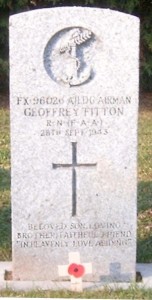
The Marine Section was located at the Marine base approximately two air miles north-west from the airport. A witness stated that a low flying aircraft passed over the base at 03.30 hours and an explosion was heard. The men in the Marine Section ran to the boat and looked over the bay with a searchlight but could observe nothing.
The conclusions of the Post Mortem by F/L Shapiro was that death was caused by drowning and that it was unlikely that the injuries were severe enough to have contributed to the pupil’s death. In view of the high winds prevailing, it was quite possible that he was drowned as a result of the waves continually rising and falling over his face. As a result of the findings, the Aerodrome Control Pilot and the Officer in charge of Night Flying were placed under arrest.
A/LA Fitton was given a military funeral on the 30th and is buried in the Cataraqui Cemetery. The twenty-year-old was survived by his parents Edwin Arnold and Augusta Victoria Fitton of Burnby, Lancashire. The chief mourner at his funeral was his brother, A/LA R. A. Fitton.
On October 1, one officer and twenty-nine naval ratings from Course 83 graduated; eleven ratings were suspended after solo failure. Two days later, on the 3rd, after an ‘unauthorized restarting engine in flight’ a Sergeant pilot and student crashed through high tension power lines, knocked over some fence posts, and brought their plane down in a field between Cataraqui and Highway 2. When the Whig Standard first queried airport officials about the accident, they denied all knowledge of it, but witnesses had seen two men walk away from the plane. They possibly were walking back to the airport and one can imagine how they were dreading having to explain an aircraft damaged seriously during an unauthorized exercise.
On 12 October 1943, F/O D. N. Dean R.C.A.F. was forced to land his Lysander plane on north Victoria Street. The Whig Standard account said: “By his clever manoeuvring he was able to avoid striking a parked automobile. The plane continued down the centre of the road about 100 yards when F/O Dean saw the parked car. He swerved to miss the car but struck a hydro pole which was broken off close to the ground. The plane continued down the street for another 100 yards before it came to a sudden stop. F/O Dean was taken to the military hospital where he was treated for shock.”
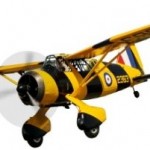
Lysanders were used to pull drogues at the bombing ranges, and one can imagine the skill it took for F/O Dean to navigate its 50 feet wing span down the street.
133 Pilots in 4 Courses Graduate in
6 Weeks with 3 Fatalities
On the 15th of October, No. 84 course graduated with one officer and twenty-nine ratings receiving their wings. Eleven were suspended after solo failure, and one from this class was killed. The next day, No. 92 Course arrived with three officers and thirty-seven ratings.
Course 85 graduated with one officer and thirty-eight ratings receiving their wings on October 29. Eleven ratings were suspended after solo failure. On the 31st, thirty-eight ratings arrived to begin training in No. 93 Course.
Course 86 graduated on November 12, with one member of the R.A.F. receiving his wings, along with one officer of the Royal Navy and thirty-two F.A.A. Thirteen of this class were suspended and one killed. Two days later, forty-one members of the F.A.A. arrived from No. 13 E.F.T.S., St. Eugene, Quebec, for Course 94.
On the 26th of November, thirty F.A.A. pupils graduated with Course 87; five were suspended, six transferred, and one killed. The next day, thirty-eight naval ratings arrived for Course 95.
P/O N. F. C. Winby, A/LA I. W. Wilkin Sharbot Lake 30 November 1943
A Harvard carrying instructor P/O Nicholas Winby and pupil A/LA Ivor Wilkin crashed in dense woods on an island seven miles south-west of the village of Sharbot Lake on November 30, 1943. Several men, including a doctor risked their lives in the attempt to rescue the airmen when they crawled on their knees over the thin ice to reach them. The first man pushed a boat in front of him, and the doctor ran across the ice with only a stick for protection in case he broke through the ice. When they reached the island, they found that both the instructor and pupil had been killed.
P/O Nicholas Frederick Charles Winby, age 19, was the son of Frederick Chas. and Violet Joan Winby of Notting Hill, London, England. A/LA Ivor William Wilkin, age 18, was the son of Alex and Margery Wilkin of Fen Ditton, Cambridgeshire.
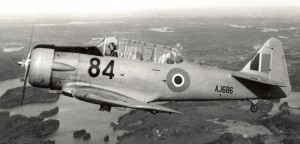
A/LA Bill Martin on a cross-country flight over Sharbot Lake.
Bill returned to live in Toronto, later residing on the Middle Road.
Night Flying Crash at Gananoque Airport
This story is from the Court of Inquiry hearing into a crash at No. 1 R.L.G. on the night of 3 December 1943 in which pupil FX112600 A/LA Arthur Wm. Welch was seriously injured and his instructor, F/O Derek Tissington, was slightly injured. The pupil was receiving initial night flying and had demonstrated to him one take-off and landing including overshoot procedure. The instructor then handed over control to the pupil who requested and was given permission to take off. After doing so, the pupil allowed the aircraft to swing to the left and the instructor corrected, handing back control to his pupil after doing so. The pupil then climbed straight ahead and began to raise the undercarriage. In doing so, he leaned forward and for some unexplained reason fainted and froze on the controls. The instructor pulled the control column back with both hands but was unable to take over control and the aircraft dove into the ground from a height of 100 to 150 feet and was totally damaged. The pupil remembered nothing.
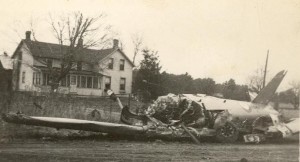
Site of Harvard’s crash landing was at Lloyd’s gate, first farm in Pittsburgh Tp. at South Lake.
These photographs are courtesy of Bill Westwood, ex-R.A.F..
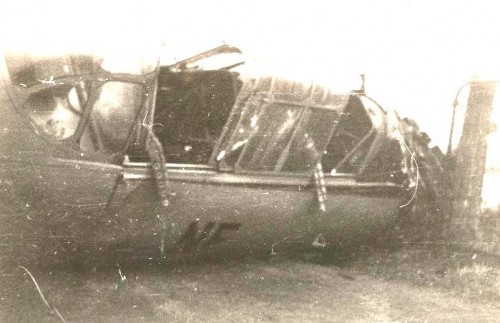
At the Court of Inquiry hearing, it was learned that A/LA Welch had been awake 17 hours when he went up for his flight. He had been on Duty Lookout from 18.00 to 22.00 hours, had supper at 22.00 hours, returned to the hangar at 23.00 hours and began his flying at 01.30 hours. The accident occurred at about 01.45.
He testified that he had had ten hours sleep, getting up at 08.00 hours in the morning. “The van which should have taken me to Gan at 10 a.m. did not leave until lunch time so that I did not arrive at Gan before 17.00 hours. Under normal circumstances, I should have taken rest but I was due for Air Control Party from 18.00 hours to 22.00 hours. I missed this. Between 22.00 hours until 01.00 hours, I was waiting in the crew room and at 01.00 hours I took off. I had nearly done my circuit with my instructor before I crashed. I felt a little sleepy in the crew room but felt fully awake in the fresh air.”
The following testified: F/L E. Sellix; S/L Peter Derrick Sammen, Senior Medical Officer; A/LA Sydney Ernest Bentley FX112412; Sgt. Wilfred Donley; LAC Dennis Marshall Lambert 1247017, Flight Mechanic Airframe at Gan; LAC Guy Parker 1023811, Electrician; LAC Albert Colclough 958066, Instrument Repairer; LAC John James Patino 1090135, Fitter.
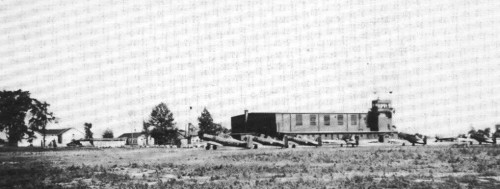
W/O Wm. M. Moffatt, A/LA G. C. Hicks – 19 December 1943
W/O William Michael Moffatt and A/LA Gordon Hicks were killed when their plane crashed near Millhaven during anti-submarine bombing practice. The plane came down in flames and the pilot was seen to be trying desperately to control his stricken plane, but it plunged forward toward the ground at high speed despite his efforts. The bodies of the two fliers were unrecognizably charred, and the largest single piece of the scattered aircraft was a wing. Site of the crash was one-half mile from the bombing range at Millhaven. The probable cause given in the C/O’s diary was that the rocker box became fractured in the air. How unfair is fate that Moffatt, who had over 2,000 flying hours to his credit in addition to operational experience gained during the Battle of Britain, should crash due to a rocker box failure.
S/L Dennis Arthur Adams, who was Officer Commanding No. 4 Group, explained that the anti-submarine depth charge exercise required the attack to be carried out at 100 ft. with a circuit of 500 ft. The Medical Officer concluded that death was instantaneous.
Giving testimony were civilian eyewitnesses Byard McCumber, his nephew John Bush and Mrs. Kathleen Bates.
Warrant Officer Moffatt had arrived on the base with the fourth echelon on January 25, 1941. He was the son of the Rev’d Arthur Stanley Moffatt and his wife, Ethel Jane, Auckland, N.Z. He was also survived by his wife Winifred Florence Moffatt of Parkeston, Essex, England. He was due for promotion and was posthumously promoted to Flying Officer. A/LA Gordon Clifford Hicks, aged only 18, was the son of Charles Gordon and Florence Lilian Hicks of New Malden, Surrey, England.
Mrs. Moffatt had intended to join her husband in Kingston but at the last minute changed her mind. It was a dangerous journey and the wife of W/O H. R. Wadley, who had arrived in the same group with W/O Moffatt, spoke of the fear of submarines on the long journey across the Atlantic. The husbands must have anxiously awaited news of the safe arrival of the ships as this was 1941 and the height of the attacks by the German Wolf Packs on Allied shipping.
The Wadleys found accommodation with a family on Smith Street in Kingston and were warmly welcomed into their home and introduced to friends. They enjoyed the happy times spent here and were one of the couples who returned to Kingston to live.
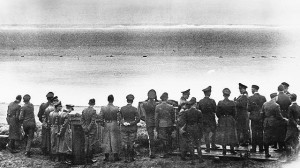
Wadley enlisted in the R.A.F. before the war and unknown then to those young men, they would play a vital role in saving Britain. After the fall of France, the German army was poised awaiting instructions that would launch Operation Sea Lion, an amphibious and airborne invasion of Britain. (Right: 1 July 1940 German officers look towards the white cliffs of Dover with anticipation.)
The Luftwaffe fought for air superiority throughout the summer and fall of 1940 in what was called The Battle of Britain. Several of the survivors came to Kingston for a season of “rest” and then returned to England. F/O Wadley was retrained as a bomber pilot and flew missions on Wellington aircraft; he served out the last months of the war in Egypt with the rank of Squadron Leader.
Christmas Dance 1943
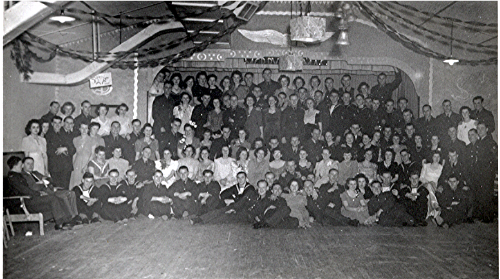
Christmas Splendor at No. 1 R.L.G.
Grand English buffet complete with boar’s head
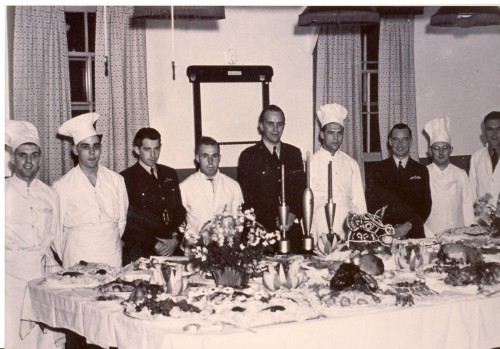
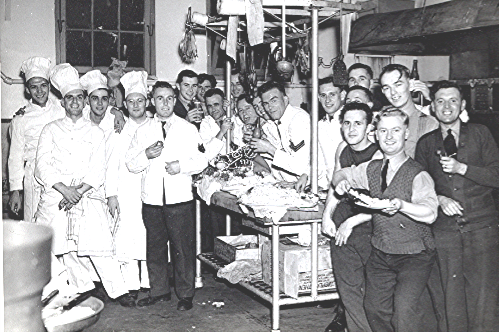
The kitchen party celebrating the success of their buffet.
With training going on smoothly on the dependable Harvard aircraft, the month of January 1944 saw seventy pilots receive their wings and another ninety-seven arrive for training. On January 3, twenty-eight naval ratings arrived for inclusion in No. 97 Course. On the 14th, No. 90 Course graduated with two officers and thirty-three ratings receiving their wings. The next day thirty-two naval ratings arrived for No. 98 Course. On the 28th, four officers and thirty-one ratings in Course No. 91 graduated. The next day, two Petty Officers and twenty-nine naval ratings arrived for No. 99 Course. They were joined by another officer, two Petty Officers and three naval ratings on the 30th. That day instructor P/O Douglas G. H. Wagner arrived on the station from No. 1 Flying Instruction School, Trenton. P/O Wagner figures in the post-war Gananoque and Kingston airports.
In January 1944, 300 wives and children of members of the R.A.F. who were stationed in various parts of Canada assembled in Montreal and later left for an American port to await embarkation for the British Isles. Included in this group were sixteen women from the Kingston district, many with children.
Opinions of Australians and New Zealanders
Houses Too Hot – Girls Are Tops
After a fellow countryman in 1941 had commented upon his arrival at No. 31 that it was colder here than he had ever imagined it could be, LAC Lindly Ashcroft of Auckland, New Zealand, made the comment to a reporter: “Canadians keep their houses far too warm and bundle up in too many clothes. The snow is really beautiful; the weather here really bucks you up no end after the fog in England.”
Canadian girls are ‘tops’ agree boys from all over the world stationed here in Canada. New Zealand, Australian and British boys under the Commonwealth Air Training Plan are unanimous in their ‘all high’ rating of Canadian belles,” from a newspaper story in February. “They must have their faults, said one Australian with a puzzled frown, ‘but so far I haven’t noticed any.” A New Zealand buddy, shivering in his greatcoat added, “Your girls counteract your weather and that’s saying a lot.
Said another Australian, “The first thing I noticed about Canadian girls is their peaches and cream complexion.” An airman from Kent, England, likes their speech: “Most of your girls have musical voices.” Another airman thought this: “They aren’t as conventional,” while one from Lancashire said what intrigued him most was that you couldn’t tell what a woman’s age was over here. “Mind you, I like it.”
In February 1944, the decision was made to slow down the Commonwealth training scheme as pilots were being turned out faster than they could be absorbed into operational squadrons in the U.K. On February 1, thirty-six naval ratings in No. 99 Course arrived; as well, thirty-seven ratings arrived for Course 100. On the 20th, three officers and thirty ratings graduated from No. 92 Course. On the 26th, thirty-four naval ratings in No. 93 Course graduated and the next day thirty-two arrived for training in Course 101. On March 12, thirty-four naval personnel arrived for Course No. 102.
A/LA Roy Tolson – 15 March 1944
A/LA Roy Richard Tolson, age 18, was crushed fatally when his Harvard crashed into the back bush of a farm on the Middle Road. He was the son of Mr. & Mrs. C. Tolson, Dewsbury, Yorkshire. There was no witness to the crash and no obvious cause was found. He was buried at the Cataraqui Cemetery with full military honours.
Twenty-nine graduates of Course 94 on posting to Moncton on March 19 and on the 24th, thirty-six naval personnel completed training. The next day, thirty Royal Navy personnel arrived for inclusion in 103 Course.
A/LA H. W. Graham-Brown – 3 April 1944
On April 3, FX113220 A/LA H. W. Graham-Brown was killed when his Harvard AJ695 crashed on the north side of Simcoe Island. The 28-year-old was the son of Rev. Wm. Graham-Brown and his wife Sybil R. of Ivydeene, Waldingfield Road, Sudbury, Suffolk.
At the Court of Inquiry, two of the local witnesses were Nathaniel Sudds and Mr. Belyea, whose small daughter had informed him that a plane had crashed. He phoned the aerodrome and proceeded to the scene. Mr. Flynn of Wolfe Island stated that he had caught a glimpse of the aircraft diving straight into the ground.
FX1811 A/LA John Muir Sturrock of Course 98, was a witness to the fact that A/LA Graham-Brown had commenced aerobatics at the lowest permissible level by performing a prohibited manoeuvre. He flew inverted for approximately 30 seconds, losing about 1000 feet before rolling out of his position. The aircraft then appeared to stall and commenced to spin, making two complete turns before recovering about approximately 500 feet. During the resulting dive the aircraft crashed into the ground on the north-west side of Simcoe Island and blew up.
The Medical Officer, Engineer Officer and a party of guards visited the scene of the accident on 4 April. The delay was caused by the extreme difficulty encountered due to ice conditions necessitating a round trip of over 14 miles. They were the first officials to arrive on the scene.
Due to the speed with which the aircraft had hit the ground, extrications of the body was very difficult, The engine was imbedded in the ground about four feet.
Giving testimony were the following: Instructor F.O J. B. Swann, F/O C. E. F. Brown; S/L N. T. Woodcock; LAC G. Spence 1455386, F.M.E.; F/O P. A. Barker; F/O E. M. Snelling; S/L Ashby, Senior Medical Officer; and Chief Investigating Officer (Accidents) G/C F. S. Wilkins.
Pupils who had flown AJ695 appearing at the Inquiry were: FX91957 A/LA J. Dixon, NZD2839 A/LA C. E. Plummer, and LAC C. E. Lee.
On April 8, thirty-three naval ratings completed course 96. On the 21st, thirty-three naval personnel graduated Course 97, and the next day twenty-nine arrived for inclusion in Course 105.
Next Chapter: 24. A Fond Farewell…
Previous Chapter: 22. Change Of Commanding Officer At NO. 1 R.L.G.